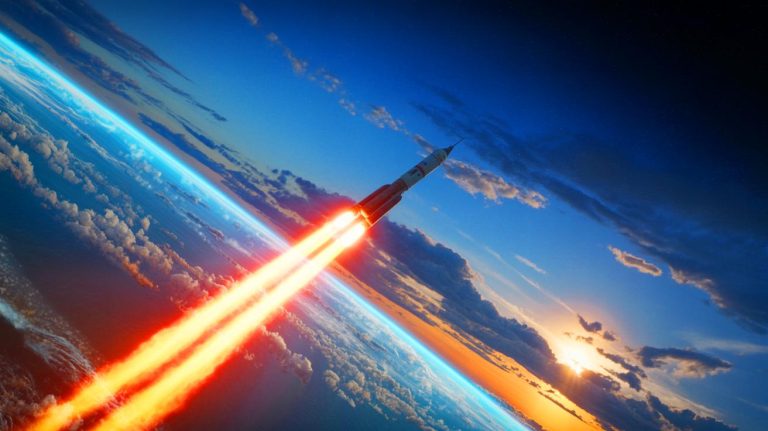| IN A NUTSHELL |
|
In a remarkable twist from the annals of space exploration history, the Soviet probe Cosmos 482 is on a collision course with Earth after orbiting for more than five decades. Originally launched with the aim of reaching Venus, this relic from the Cold War space race is set to re-enter Earth’s atmosphere. As its journey nears an end, questions abound about the probe’s contents and the scientific value it still holds. This unexpected return highlights not only the durability of Soviet-era technology but also the ongoing concerns about space debris orbiting our planet.
A Relic of the Space Race
In the fervor of the Cold War, the space race was a battleground for technological supremacy. On March 31, 1972, the Soviet Union launched the Cosmos 482 mission as part of its ambitious Venera program aimed at exploring Venus. Designed as a twin to the successful Venera 8, Cosmos 482 was equipped to land on Venus and gather vital data about its hostile atmosphere. However, fate intervened. Shortly after launch, a critical failure in the “Block L” upper stage of its rocket prevented the probe from reaching escape velocity. Instead, Cosmos 482 fragmented, leaving parts in low Earth orbit, with the main probe and part of the engine trapped in a higher elliptical orbit.
Instead of a brief interplanetary journey, Cosmos 482 began an unexpected fifty-year odyssey around our planet. Initially orbiting at 130 miles at its closest and about 6,100 miles at its farthest, the satellite’s path has gradually decayed due to atmospheric drag. NASA experts now predict its re-entry between May 7 and 13, 2025, with a more precise estimate around May 10. This unintended orbital dance provides a rare opportunity to study the longevity of space materials and the dynamics of orbital decay over an extended period.
Scientific and Historical Significance
The burning question is whether any fragments of Cosmos 482 will survive to reach the Earth’s surface. The descent module, weighing 1,091 pounds, was specially armored to endure a high-speed entry into Venus’s dense and corrosive atmosphere, a far more demanding environment than Earth’s. This original sturdiness suggests that it, or at least a substantial portion, could withstand the fiery descent to Earth.
Recent observations by Dutch astronomer Ralf Vandebergh have added an air of mystery. Images show an elongated shape trailing the object, likely its parachute, which measures about 27 square feet. If deployed prematurely or partially, this parachute is unlikely to survive the intense friction of re-entry. As for the impact point, Earth’s vast oceans make a water landing likely, minimizing risks to populated areas.
The Cosmos 482 probe, particularly its descent module, is not a hollow shell. It is a pressurized and insulated sphere designed as a miniature laboratory. It housed a suite of scientific instruments intended to analyze the Venusian environment, including sensors for temperature, pressure, and atmospheric density, an accelerometer, a radio altimeter, an anemometer, a gamma spectrometer, a gas analyzer, and photometers. These instruments were powered by batteries and designed to transmit data via radio. Importantly, the probe contains no hazardous radioactive materials, as it was a scientific exploration mission. Its value lies in its design and the technologies it carried, showcasing Soviet expertise from the 1970s.
Implications for Space Debris
Beyond its dramatic re-entry, the return of Cosmos 482 is of genuine interest to the scientific community and space historians. If debris is recovered, analysis could provide valuable insights into how materials and systems age after more than five decades in a hostile space environment. It also serves as a tangible reminder of a fascinating era of space exploration, marked by bold ventures to our planetary neighbors.
This event also highlights the growing issue of space debris. Every launch and mission, even failed ones from long ago, contributes to the clutter in Earth’s orbits. The fall of Cosmos 482 is a visible manifestation of this problem, which increasingly concerns space agencies worldwide as they seek solutions to mitigate risks for current and future missions. Cosmos 482’s return is thus a multifaceted event: a celestial curiosity, a technological time capsule, and a reminder of our lasting impact on the circumterrestrial environment. As we await the final chapter of this unfinished space odyssey, it raises an intriguing question: How will we manage the legacy of our past explorations while paving the way for future endeavors?
Did you like it? 4.4/5 (20)








Wow, 53 years of orbiting! I wonder what’s inside that probe? 🤔
Isn’t it dangerous for space debris to fall back to Earth? 🌍
This sounds like something out of a sci-fi movie! 🚀
What if it lands in my backyard?! 😱
How much of a threat does this pose, really?
Thank you for such an interesting article. Fascinating stuff! 😊
Why did it take so long for Cosmos 482 to re-enter Earth’s atmosphere?
Can’t believe Soviet tech is still up there after all these years. Impressive!
I hope NASA has a plan if this thing lands near a city.
Are there any similar probes still floating around up there?